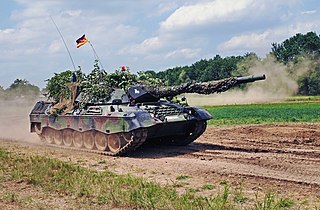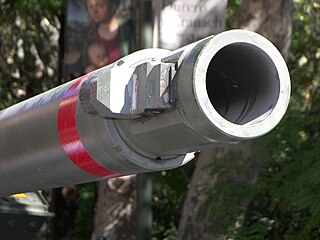
The Leopard is a main battle tank designed and produced by Porsche in West Germany that first entered service in 1965. Developed in an era when HEAT warheads were thought to make conventional heavy armour of limited value, the Leopard focused on firepower in the form of the German-built version of the British L7 105-mm gun, and improved cross-country performance that was unmatched by other designs of the era.
A black panther is a colour variant of any Panthera, particularly of the leopard and the jaguar.
A torsion bar suspension, also known as a torsion spring suspension, is any vehicle suspension that uses a torsion bar as its main weight-bearing spring. One end of a long metal bar is attached firmly to the vehicle chassis; the opposite end terminates in a lever, the torsion key, mounted perpendicular to the bar, that is attached to a suspension arm, a spindle, or the axle. Vertical motion of the wheel causes the bar to twist around its axis and is resisted by the bar's torsion resistance. The effective spring rate of the bar is determined by its length, cross section, shape, material, and manufacturing process.

The Leopard 2 is a main battle tank originally developed by Krauss-Maffei in the 1970s for the West German army. The tank first entered service in 1979 and succeeded the earlier Leopard 1 as the main battle tank of the German Army. It is armed with a 120 mm smoothbore cannon, and is powered by a V-12 twin-turbo diesel engine. Various versions have served in the armed forces of Germany and 13 other European countries, as well as several non-European nations, including Canada, Chile, Indonesia and Singapore. The Leopard 2 was used in Kosovo with the German Army, and has seen action in Afghanistan with the Dutch, Danish and Canadian contributions to the International Security Assistance Force, as well as seeing action in Syria with the Turkish Armed Forces.

The Type 90 tank is a main battle tank (MBT) of the Japan Ground Self-Defense Force (JGSDF). It was designed and built by Mitsubishi Heavy Industries as a replacement for the Type 61 and to supplement the then current fleet of Type 74 tanks, and entered service in 1990. It is to be superseded by the Type 10 tank.

The Flugabwehrkanonenpanzer Gepard is an all-weather-capable German self-propelled anti-aircraft gun (SPAAG). It was developed in the 1960s and fielded in the 1970s, and has been upgraded several times with the latest electronics. It constituted a cornerstone of the air defence of the German Army (Bundeswehr) and a number of other NATO countries. In Germany, the Gepard was phased out in late 2010 and replaced by Wiesel 2 Ozelot Leichtes Flugabwehrsystem (LeFlaSys) with four FIM-92 Stinger or LFK NG missile launchers. A variant with the MANTIS gun system and LFK NG missiles, based on the GTK Boxer, was also considered.
The leopard is one of the five "big cats" in the genus Panthera.

Trophy is a military active protection system (APS) designed to protect vehicles from ATGMs, RPGs, anti-tank rockets, and tank HEAT rounds. A small number of explosively formed projectiles destroy incoming threats before they hit the vehicle. Its principal purpose is to supplement the armour of light and heavy armored fighting vehicles. Developed by Rafael Advanced Defense Systems Ltd. of Israel and currently fielding over 1,000 systems to all major Israeli ground combat platforms, as well as U.S. Abrams M1A1/2, and tested on the Stryker APCs and Bradley AFVs. Trophy protects against a wide variety of anti-tank threats, while also maximizing the vehicle's ability to identify enemy location to crews and combat formation, thereby providing greater survivability and maneuverability in all combat theatres.

The Rheinmetall Rh-120 is a 120 mm smoothbore tank gun designed and produced by the West German Rheinmetall-DeTec AG company, developed in response to Soviet advances in armor technology and development of new armored threats. Production began in 1974, with the first version of the gun, known as the L/44 as it was 44 calibers long, used on the German Leopard 2 tank and soon produced under license for the American M1A1 Abrams and other tanks. The 120-millimeter (4.7 in) gun has a length of 5.28 meters (17.3 ft), and the gun system weighs approximately 3,317 kilograms (7,313 lb).

An armoured vehicle-launched bridge (AVLB) is a combat support vehicle, sometimes regarded as a subtype of military engineering vehicle, designed to assist militaries in rapidly deploying tanks and other armoured fighting vehicles across gap-type obstacles, such as rivers. The AVLB is usually a tracked vehicle converted from a tank chassis to carry a folding metal bridge instead of weapons. The AVLB's job is to allow armoured or infantry units to cross craters, anti-tank ditches, blown bridges, railroad cuts, canals, rivers and ravines), when a river too deep for vehicles to wade through is reached, and no bridge is conveniently located.

Stridsvagn 122 (IPA: [ˈstrɪ̂tːsvaŋn]; is a Swedish main battle tank based on the German Leopard 2 improved variant, just like the German Leopard 2A5, utilizing newer technology such as command-, control-, and fire-control systems, as well as reinforced armour and long-term combat capacity. Externally, the vehicle can be distinguished from the Leopard 2A5 by the French GALIX smoke dispensers, different storage bins, and the thicker crew hatches. The Strv 122B, has been equipped with modular AMAP composite armor from IBD Deisenroth to give "360° protection" against threats such as explosively formed penetrators, rocket propelled grenades and improvised explosive devices.

The Leopardo 2E or Leopard 2A6E is a variant of the German Leopard 2 main battle tank, tailored to the requirements of the Spanish army, which acquired it as part of an armament modernization program named Programa Coraza, or Program Cuirass. The acquisition program for the Leopard 2E began in 1994, five years after the cancellation of the Lince tank program that culminated in an agreement to transfer 108 Leopard 2A4s to the Spanish army in 1998 and started the local production of the Leopard 2E in December 2003. Despite postponement of production owing to the 2003 merger between Santa Bárbara Sistemas and General Dynamics, and continued fabrication issues between 2006 and 2007, 219 Leopard 2Es have been delivered to the Spanish army.

The Panzer 68 was a Swiss main battle tank developed by the Eidgenoessische Konstruktionswerkstaette in Thun in the late 1960s, and was the main tank of the Swiss Army until the late 1990s.

The Versuchsträger1-2 were two German prototype twin gun turretless main battle tanks. Since the early 1970s a number of West German companies have been working on conceptual designs for a successor to the Leopard 1. This project had the name Kampfpanzer 3. The KPz 3 project was temporarily a British-German joint project, until the UK withdrew because they wanted a turreted tank. The Germans had already developed the Leopard 2 and therefore didn't see the need for another conventional tank. One of the companies involved was MaK, developing the VT 1-1 and VT 1-2. The test programme ended proving that a twin-gunned turretless tank could be created with enough technical effort, but had drawbacks in both practical and tactical use.

The Main Ground Combat System (MGCS) is a project by France and Germany since 2012 to replace their currently deployed Leclerc and Leopard 2 main battle tanks (MBTs). In 2016, the program was in the concept phase which was projected to be completed by 2017.

The Leopard 2PL is a main battle tank used by the Polish Armed Forces, and is a modernized version of the older Leopard 2A4 tank, phased out by Germany and first acquired by Poland in the 2000s. The modernisation is currently being carried out in cooperation with Rheinmetall and the Polish Armaments Group.












